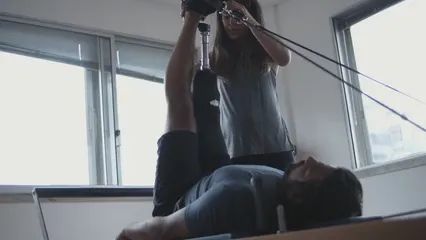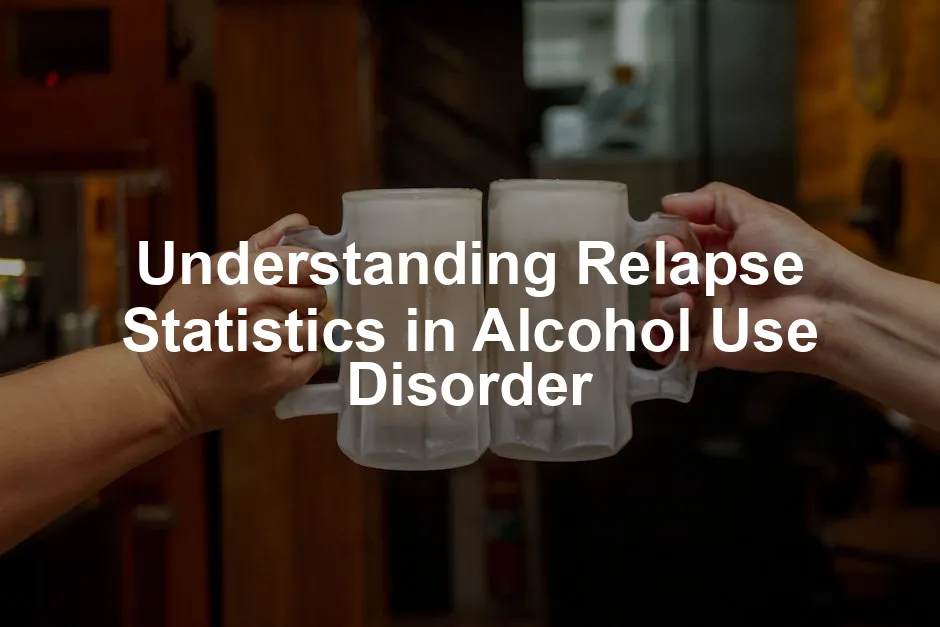Introduction
Alcohol use disorder (AUD) is a widespread issue affecting millions. It’s more than just a bad habit; it’s a serious condition that disrupts lives, families, and communities. Approximately 29 million people in the U.S. faced AUD last year, highlighting its prevalence.
Understanding relapse statistics is crucial for anyone on the road to recovery. Recovery is a journey, and knowing the statistics can help set realistic expectations. For individuals battling AUD, these numbers offer insight into common struggles and the potential for setbacks. Support systems, friends, and family can also benefit from this knowledge, as it helps them understand the complexities of recovery.
This article aims to provide comprehensive insights into relapse statistics related to alcohol use disorder. We’ll discuss the factors influencing relapse, the psychological aspects of recovery, and effective strategies for prevention. By unpacking these elements, we hope to empower individuals and their support systems in their journey toward lasting sobriety.

I. Defining Relapse in Alcohol Use Disorder
A. What is a Relapse?
Relapse refers to returning to alcohol use after a period of abstinence. It can feel like hitting the reset button on recovery. Not all relapses are equal, though. A lapse is a brief return to drinking, while a full relapse involves a significant return to alcohol use and associated behaviors.
Understanding these differences is essential for anyone recovering from AUD. Recognizing a lapse as a minor setback can help individuals avoid the emotional turmoil often associated with a full relapse.
B. The Psychological Perspective
From a psychological standpoint, relapse is a process, not just an event. It often progresses through emotional, mental, and physical stages. Initially, individuals may experience emotional distress, leading to neglect of self-care. This can evolve into mental conflict, where cravings and thoughts about drinking intensify.
Ultimately, these emotional and mental struggles can culminate in a physical relapse, marking a return to drinking. Awareness of these stages can empower individuals to catch warning signs early and seek support before reaching the point of no return.
C. Stigmatization of Relapse
Unfortunately, relapse carries a stigma that can be detrimental. Many view it as a personal failure rather than a common hurdle in the recovery journey. It’s vital to understand that relapse is often a normal part of recovery.
Acknowledging this reality can foster a more compassionate approach to recovery. Support systems should emphasize understanding and encouragement rather than judgment. Everyone’s path to sobriety is unique, and setbacks do not define an individual’s worth or commitment to recovery.
By redefining relapse as a learning opportunity, individuals can regain their footing and continue moving toward their goals.

If you’re looking for guidance on addiction recovery, consider reading “The Recovery Book: Answers to All Your Questions About Addiction and Alcoholism” by Al J Mooney M.D.. This book is packed with insights and answers that can illuminate the path to recovery.
II. Alcohol Relapse Statistics
A. General Statistics
Relapse is a significant concern for individuals recovering from alcohol use disorder (AUD). Research shows that about 90% of individuals with a history of alcohol addiction will experience at least one relapse in their lifetime. This statistic isn’t just a number; it’s a reminder of the challenges faced on the road to recovery.
The first year of sobriety is particularly tough. Studies indicate that 50% of those in recovery will relapse within this timeframe. It’s like trying to walk a tightrope without a net, where the stakes are incredibly high. The numbers don’t lie: relapse rates for individuals in recovery hover between 40% and 60%. This is comparable to rates for other chronic conditions, such as hypertension and asthma.
Understanding these statistics is vital. They serve as a wake-up call for those on the recovery journey and their support systems, highlighting the importance of ongoing vigilance and support. Recovery is not a straight path; it’s a winding road filled with bumps and turns.

To dive deeper into the recovery process, check out “Clean: Overcoming Addiction and Ending America’s Greatest Tragedy” by David Sheff. This book provides a comprehensive view of addiction and recovery, helping you understand the underlying issues better.
B. Age and Gender Differences
Age and gender play crucial roles in relapse statistics. Research shows that individuals aged 18 to 25 experience the highest relapse rates. Not only is this age group navigating the challenges of young adulthood, but they also face unique social pressures, making recovery particularly daunting.
Gender differences add another layer of complexity. Men generally have higher relapse rates compared to women. Studies indicate that 53% of men relapse, while only 40% of women do. This disparity could stem from varying social expectations and coping mechanisms. Men often face societal pressures to conform to certain behaviors, which may increase their risk of relapse.
It’s essential to recognize these differences when approaching treatment and support. Tailoring recovery strategies to address the specific challenges faced by different age groups and genders can significantly enhance outcomes.

C. Impact of Treatment Duration
The duration of treatment is another critical factor influencing relapse rates. Individuals who complete at least three months of treatment show markedly lower relapse rates compared to those who engage in shorter treatment programs. Research suggests that longer treatment durations lead to more robust coping mechanisms and a stronger foundation for sobriety.
Specifically, 60% of individuals who undergo at least three months of treatment manage to maintain their sobriety long-term. In contrast, those who receive less than three months of treatment face relapse rates that can soar above 70%. This stark difference underscores the importance of comprehensive and sustained treatment efforts.
Ongoing support and resources are vital during and after treatment. Engaging in support groups or therapy can help individuals reinforce the skills they learned in treatment, reducing the risk of relapse dramatically.

If you’re looking for practical tools to help in your recovery, consider picking up “The Mindfulness Workbook for Addiction: A Guide to Coping with the Urge to Use” by Rebecca E. Williams. This workbook is a valuable resource for developing mindfulness techniques that can assist in managing cravings and urges.
D. Relapse Triggers and Contributing Factors
Understanding the common triggers for relapse can empower individuals in recovery. Stress tops the list, with up to 60% of relapses attributed to stress-related factors. Life’s pressures can feel overwhelming; it’s crucial to develop effective coping strategies to manage stress.
Isolation is another significant contributor. Individuals who feel socially isolated may struggle more with cravings and the temptation to drink. It’s important to foster connections with supportive friends and family.
Co-occurring mental health disorders, such as anxiety and depression, also play a significant role. Nearly 50% of individuals with relapses report having comorbid mental health issues. This overlap highlights the need for integrated treatment approaches that address both addiction and mental health simultaneously.
Recognizing these triggers can help individuals prepare and build resilience. By developing a personalized relapse prevention plan, they can equip themselves to face challenges head-on.
In conclusion, relapse statistics paint a vivid picture of the complexities surrounding alcohol use disorder and recovery. From general rates to age and gender differences, treatment duration, and trigger awareness, these insights are critical for anyone navigating recovery. Understanding and utilizing this information can lead to more effective strategies and a clearer path toward lasting sobriety.

III. Understanding the Stages of Relapse
A. Emotional Relapse
Emotional relapse is the first stage of the relapse process. In this phase, individuals aren’t actively thinking about drinking. Yet, their emotions and behaviors may subtly lead them down that slippery slope. Warning signs include neglecting self-care, isolating from friends and family, and skipping support meetings.
People might bottle up their feelings, leading to internal turmoil. Sleep disturbances and poor eating habits often creep in as well. It’s like carrying a backpack full of heavy stones, slowly weighing you down. Recognizing these signs early can be crucial.
Understanding emotional relapse is vital. It serves as a red flag, signaling the need for self-checks or even seeking help. The sooner individuals can identify these feelings, the better equipped they are to avoid the next stage.

B. Mental Relapse
Mental relapse is a stage filled with internal conflict. It’s a tug-of-war between the desire to stay sober and the craving for alcohol. During this phase, individuals may start to romanticize past drinking experiences. Thoughts might drift to old friends, parties, or that one carefree night out.
Indicators of mental relapse can include planning to drink again or justifying past drinking behavior. The mind might create scenarios where drinking seems harmless. It’s like a thief in the night, sneaking in and stealing away your resolve.
Cravings intensify during this stage. Individuals may find themselves bargaining with their thoughts: “Just one drink won’t hurt.” This back-and-forth can be exhausting, leading to heightened anxiety. Being aware of these mental battles can help in taking proactive steps to combat them.

C. Physical Relapse
Physical relapse marks the actual return to drinking. This stage often follows emotional and mental relapses, making it the most critical to prevent. Triggers such as stress, social situations, and environmental cues can lead to this relapse. Picture it as a game of dominoes; one small push can send everything tumbling down.
Common triggers include high-stress situations, being around others who drink, or even feeling isolated. The risk multiplies when individuals underestimate their ability to resist temptation. Recognizing these triggers is key to creating an effective relapse prevention strategy.
It’s important to remember that a physical relapse doesn’t mean failure. It can serve as a learning experience. Each relapse can provide insights into what went wrong, helping individuals strengthen their defenses against future slips. Building a robust support system and maintaining open communication can be the safety net needed to catch them before they fall.

IV. Strategies for Preventing Relapse
A. Treatment Options
Effective treatment options play a pivotal role in preventing relapse. Medication-assisted treatment (MAT) is one such method that has shown success. Medications like naltrexone and acamprosate can help manage cravings and withdrawal symptoms, making recovery less daunting.
Therapy, including cognitive-behavioral therapy (CBT), also holds significant merit. CBT helps individuals identify and change negative thought patterns related to drinking. This approach empowers them to develop healthier coping strategies. Combining these methods increases the chances of maintaining sobriety.
Support groups, like Alcoholics Anonymous (AA), provide a community of understanding. Regular attendance at these meetings fosters accountability and shared experiences. It’s like having a safety net woven from the experiences of others who understand the struggles of recovery.

If you’re searching for a profound read on addiction, check out “Alcoholics Anonymous: The Big Book” by Alcoholics Anonymous. This seminal work has guided countless individuals through their recovery journeys and offers invaluable insights into overcoming addiction.
B. Support Systems
Family and peer support are crucial in preventing relapse. A strong support network can provide the encouragement needed during tough times. Studies show that involving family members in the recovery process can improve success rates by up to 50%. They can help monitor behaviors, offer emotional support, and even participate in family therapy sessions.
Peer support groups, such as AA, have proven effective as well. Statistics indicate that individuals who regularly attend meetings have a lower likelihood of relapse. The shared experiences create a sense of belonging, making individuals feel less isolated in their struggles.
The importance of community cannot be overstated. A robust support system acts as a buffer against the challenges of recovery. It’s like having a cheerleading squad, rooting for you every step of the way. Engaging with both family and peer support can solidify the foundation of a successful recovery journey.
By combining effective treatment options with strong support systems, individuals can significantly decrease their risk of relapse. Awareness and proactive engagement in recovery strategies can lead to a healthier, more fulfilling life free from the chains of alcohol addiction.

C. Coping Mechanisms and Lifestyle Changes
Developing healthy coping strategies is essential for those in recovery. Here are some tips to help you on this journey:
- Practice Mindfulness: Mindfulness techniques can help ground you. Focus on your breath, and let go of negative thoughts. Apps like Headspace or Calm can guide you through meditation.
- Engage in Physical Activity: Exercise isn’t just about fitness; it’s a fantastic mood booster. Whether it’s jogging, yoga, or dancing like nobody’s watching, find what makes you feel alive.
- Establish a Routine: Create a daily schedule to keep yourself occupied. A routine can provide structure and reduce the chances of falling back into old habits.
- Seek Support: Surround yourself with positive influences. Whether it’s family, friends, or support groups, having a solid network can make a world of difference.
- Explore New Hobbies: Find activities that spark your interest. Painting, gardening, or cooking can serve as excellent outlets for stress and creativity.
Lifestyle changes also play a significant role in recovery. Here are a few key areas to consider:
- Exercise Regularly: Physical activity not only improves health but also reduces stress. Aim for at least 30 minutes a day. Whether it’s a brisk walk or a gym session, get moving!
- Mindfulness Practices: Techniques like meditation and yoga can help maintain mental clarity. These practices enhance self-awareness and emotional regulation.
- Nurture Healthy Relationships: Surround yourself with supportive individuals. Healthy relationships foster a sense of belonging and can boost your motivation to stay sober.
Making these changes can lead to a more balanced life. They pave the way for healthier coping mechanisms, reducing the likelihood of relapse. Remember, recovery is a journey, and every step counts!

For those interested in enhancing their self-care practices, consider getting a yoga mat. Practicing yoga can help reduce stress and improve your overall well-being.
V. Consequences of Relapse
A. Health Risks
Relapse can carry severe health risks, particularly for those recovering from alcohol use disorder. One of the most alarming dangers is overdose. After a period of abstinence, the body’s tolerance to alcohol decreases. This means that even a small amount can lead to severe consequences. In fact, studies suggest that individuals who relapse may be at risk of overdosing due to this lowered tolerance.
Furthermore, relapsing can lead to a plethora of health issues, including liver damage, cardiovascular problems, and increased risk of accidents. The physical toll can be immense, making it crucial for individuals in recovery to recognize the gravity of returning to alcohol use.

B. Emotional and Psychological Impact
The emotional fallout from a relapse extends beyond the individual. Families often bear the brunt of this distress. For the person in recovery, a relapse can trigger feelings of guilt, shame, and disappointment. These feelings can spiral into a cycle of negative emotions, making it harder to regain footing in recovery.
Family members may experience anxiety and frustration as they witness their loved one struggle. This emotional toll can strain relationships, leading to further isolation. It’s vital to remember that relapse is a common part of the recovery journey, not a definitive failure.
Acknowledging the emotional impact is essential for healing. Support groups, therapy, and open communication can help mend the emotional wounds caused by relapse. By addressing these feelings, individuals can find a pathway back to recovery, armed with a renewed sense of purpose and understanding.
As part of your emotional toolkit, consider using a weighted blanket. These blankets can provide comfort and help reduce anxiety during challenging times.

FAQs
What percentage of alcoholics relapse?
About 90% of individuals who struggle with alcohol use disorder (AUD) will experience at least one relapse in their lifetime. This staggering number highlights the challenges faced by those in recovery. Additionally, approximately 50% who experience a lapse in sobriety will transition into a full relapse.
How can I prevent a relapse?
Preventing relapse involves several strategies. Firstly, adhering to an individualized treatment plan is crucial. Building strong relapse-prevention skills and remaining open to care can significantly enhance your chances of success. Additionally, identifying early warning signs from the emotional and mental stages of relapse can help you take proactive steps to maintain your sobriety.
Is relapse common among those recovering from alcohol use disorder?
Yes, relapse is quite common among individuals recovering from AUD. It is often viewed as a normal part of the recovery process rather than a failure. Understanding this can help individuals and their support systems to approach recovery with more compassion and resilience.
What are the warning signs of an impending relapse?
Some common warning signs that may indicate an impending relapse include neglecting self-care, isolating from loved ones, and experiencing heightened emotional distress. Additionally, skipping support meetings and having cravings for alcohol are critical indicators that should be monitored closely.
Should I seek treatment again if I relapse?
Yes, seeking treatment after a relapse is vital. It provides an opportunity to reassess your recovery strategies and reinforce your commitment to sobriety. Returning to treatment can offer the support needed to navigate the complex journey of recovery, and many individuals find renewed motivation and tools for success through this process.
Please let us know what you think about our content by leaving a comment down below!
Thank you for reading till here 🙂
All images from Pexels




